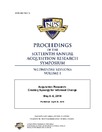Innovations in Defense Acquisition Auctions: Lessons Learned and Alternative Mechanism Designs
| dc.contributor.author | Coughlan, Peter | |
| dc.contributor.author | Lamping, Jennifer | |
| dc.contributor.author | Gates, William | |
| dc.date | 01-Feb-08 | |
| dc.date.accessioned | 2013-05-08T21:15:22Z | |
| dc.date.available | 2013-05-08T21:15:22Z | |
| dc.date.issued | 2008-02-01 | |
| dc.identifier.uri | https://hdl.handle.net/10945/33269 | |
| dc.description | Sponsored Report (for Acquisition Research Program) | en_US |
| dc.description.abstract | Since 1997, the Department of Defense (DoD) has shown increasing interest in using reverse auctions, particularly electronic reverse auctions, to purchase a wide range of products and services. The research describes DoD''s experience with acquisition auctions, identifying the characteristics of the buyers, sellers, and the products/services exchanged through auctions. In general, reverse auctions have been limited to procurement actions involving relatively standard price-driven commercial products''products typically purchased through traditional competitive markets. It appears that DoD has substituted reverse auctions for the market research required in the standard DoD procurement processes | en_US |
| dc.description.abstract | the auction service providers are replacing federal procurement agents in advertising the procurement action and soliciting bids from competing suppliers. Drawing on this background, this research examines auction mechanism(s) that appear appropriate for the defense acquisition environment. Two specific auction designs are explored. The first is a two-stage Iterated Information Aggregation Auction (I2A2) involving multiple product characteristics''including price''that are specified as part of the auction bidding process. In the I2A2, the first stage acts as market research for gathering information dispersed across the decentralized contractor base to establish characteristic weights to evaluate proposals in the second stage. The research showed significant potential performance improvements when decentralized trade-off information is centralized through the I2A2 mechanism. The second auction mechanism involves situations where the quality of fit between the buyer and seller affect the transaction''s value (e.g., synergy between an author and an editor, etc.). This analysis explores the impact of asymmetric information on the mechanism''s design. The research developed optimal mechanisms for transactions where both parties know the quality of fit and transactions in which only one party (the buyer or sellers) know the quality of fit. | en_US |
| dc.description.sponsorship | Naval Postgraduate School Acquisition Research Program | en_US |
| dc.title | Innovations in Defense Acquisition Auctions: Lessons Learned and Alternative Mechanism Designs | en_US |
| dc.type | Technical Report | en_US |
| dc.contributor.department | Acquisition Management | |
| dc.contributor.department | NPS Faculty | |
| dc.subject.author | Reverse Auctions | en_US |
| dc.subject.author | Department of Defense (DoD), Reverse Auctions, Electronic Reverse Options | en_US |
| dc.identifier.npsreport | NPS-AM-08-013 | |
| dc.description.distributionstatement | Approved for public release; distribution is unlimited. | |
| dc.description.distributionstatement | Approved for public release; distribution is unlimited. |
Files in this item
This item appears in the following Collection(s)
-
Acquisition Management (NPS-AM)
-
Acquisition Research Symposium
-
All Technical Reports Collection
Includes reports from all departments.





